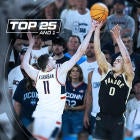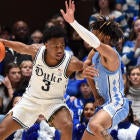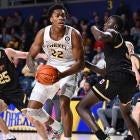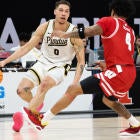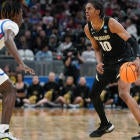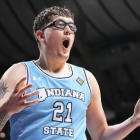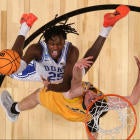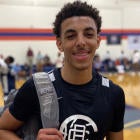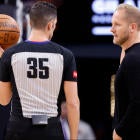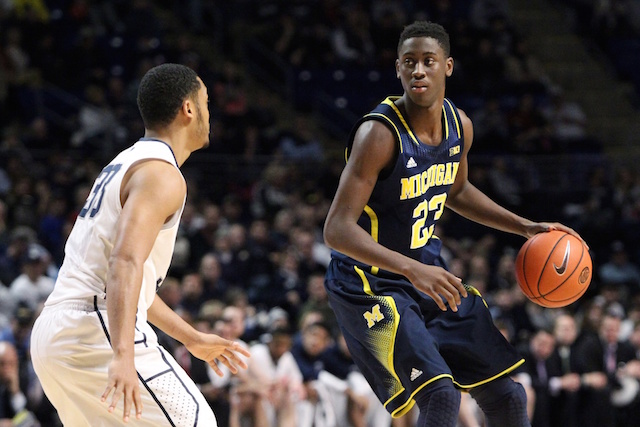
News broke on Sunday that Michigan guard Caris LeVert will be sidelined for 12 weeks due to a complete fracture of his left foot.
The injury not only effectively ends his season at Michigan, but it also potentially ends his collegiate career. LeVert, a junior, will have a decision to make regarding the NBA draft by April 26 -- the early entry deadline for underclassmen. Given the 12-week recovery period set by his doctors, the 6-foot-7 wing should have a good indication of how he feels in regard to workouts prior to that date. That should make for an easier decision on his part, although there is still no indication as to which way he is currently leaning.
If he does decide to declare, LeVert should become one of the most sought-after backcourt players in what is a rather weak class for guards. On my most recent big board, LeVert was placed at 15th overall, which was fourth among all guards. Even if he falls slightly from that position as other players rise, LeVert would still comfortably be a first-round pick not only due to the dearth of skilled guards in this draft, but also due to his high skill level.
Here's a quick scouting report on what NBA teams could potentially be getting in the current Wolverine.
As mentioned above, at 6-foot-7 and 200 pounds with a reported 7-foot-1 wingspan, LeVert would have above-average size and excellent length for an NBA shooting guard. In fact, with that length he'll be able to slide seamlessly between both wing positions -- a factor that will make him much easier to hide defensively, which we'll get to momentarily.
But before we talk defense, let's discuss the other end, as LeVert is one of the more complete offensive players in the draft and has potential to improve upon his few weaknesses.
LeVert is averaging 14.9 points per game. First and foremost, the skill that one notices most with him is his shooting ability. Over the past two seasons, he's knocked down over 40 percent of his 226 3-point attempts -- which is good for fourth in the Big Ten over that period among players who have taken at least 200 shots.
This is a good example of what makes LeVert such a good shooter, especially in spot-up situations. He does a lot of his work before the ball even gets there, squaring his feet to the rim and getting his hands out in front of his body to receive the pass. The pass from Albrecht is just slightly low for his shooting pocket, but LeVert's able to accept the pass and utilize his quick release to get the ball up to the rim.
Here's another example from the same game. Check out how balanced his shot is. He gets his legs under him, and his center of gravity always looks to be perfect. He's never leaning one way or the other, and never top-heavy or bottom-heavy. His shot off the catch is one of the more pure strokes in college hoops.
Mostly, that holds when he goes off the dribble into a jumper. Here's an example from the same game.
There are a few different things going on here, but first let's talk about his shot. Last year, he struggled a bit shooting off of the dribble. But looking at that, it's hard to see why. LeVert goes up in the same way that he did off the dribble: balanced (albeit with a slight fadeaway here), with a quick trigger and an excellent follow-through. While the numbers don't bear this out, I think LeVert can be a solid shooter off the dribble in time.
But let's talk about his ball-handling. Generally, LeVert is a really good ball-handler for a 6-7 guy. Mostly, he gets by with good stop-start ability, like he shows here against Penn State's Geno Thrope. He utilizes a hard dribble to make the defender believe he's going to the rim, but instead stops and pops from 17-feet. That's a pretty standard move for the Michigan guard, who also has pretty solid change-of-direction dribbling ability, which you'll see momentarily in his crossover. He can get that 17-footer whenever he wants.
The question with him is more whether or not he can get to the rim. Despite his excellent shooting ability, LeVert's efficiency and percentages haven't been particularly great over the past two seasons. Last season's 56 percent true-shooting percentage was solid when he had Nik Stauskas taking away some of the attention, but this season it dipped to 53.6 percent. This is a two-fold issue.
First, LeVert sometimes falls in love with his jump shot, and doesn't really make an attempt to get to the rim. This season, LeVert has only taken 16 percent of his shots at the rim. That's most comparable to guys who profile more as spot-up 3-point gunners in the NBA like R.J. Hunter (14.9), C.J. Wilcox (18.2), Rodney Hood, (18.9) and Reggie Bullock (13.8). So what gives for a big guy like LeVert that has solid ball-handling ability?
I think it's probably a combination of two factors. First off, LeVert can tend to settle and fall in love with his jumper. All of the players above took between 52 and 55 percent of their shots from 3-point range. However, LeVert only takes 35 percent of his shots from beyond the arc, which means that he's taking quite a few midrange jumpers instead of going all the way to the rim (only 18 percent of his midrange shots are assisted as well, meaning he's taking quite a few pull-ups).
When you have a jumper as good as LeVert's, settling is not preferable but it's understandable. However, he could be much more efficient if he did things like this more often:
Now, Ohio State's Marc Loving isn't a great defender. But check out the low crossover with the sudden, quick change-of-direction from LeVert on the wing. And then check out the finish, where LeVert displays excellent body control, seemingly changing his flight path in mid-air to finish the up-and-under. These are skills that he has and should take advantage of them more. Why doesn't he?
The second aspect of LeVert's desire to pull-up is probably that he's not quite yet confident of his own strength. When LeVert arrived on Michigan's campus in 2012, he was a scrawny 6'5, 165 pounds. As mentioned above, he's put on 35 pounds in the three years since then, now weighing in at 200.
Here's a photo put together by Thomas Beindit of Big Ten Powerhouse that shows LeVert's body transformation in just over two seasons:
As he continues to get more and more comfortable with his own strength, my guess is that he will start to go to the rim more often. And given his length, grace and newfound strength, he would profile well to finish at the rim well. But still, there's always the chance that the slashing part of his game never comes along, and he becomes more of a shooter.
It's also worth mentioning on the offensive end that LeVert has really great vision, and may even be able to steal some minutes eventually as an offense's primary ball-handler. He's currently averaging 3.7 assists per game at Michigan, and is in the top-10 of the Big Ten in assist percentage.
Even though LeVert has generally struggled scoring in the pick-and-roll this season, he does have excellent potential as a pick-and-roll decision maker. Look at how he patiently draws the big defender, Illinois' Nnanna Egwu (one of the best defenders in the conference) toward him, waits for the help defender to vacate back out to Zak Irvin at the 3-point line, then makes the perfect pass to Ricky Doyle for the finish. It's a really smart, patient play for a young player.
Here's another example of his playmaking ability:
LeVert gets the hand-off from Walton here, and comes around from the wing and gets into the paint. From there, he recognizes Egwu step up makes the excellent bounce pass drop off to Doyle again. He'll probably be at his best making decisions like this from the wing on either pure isolation slashes or side pick-and-rolls.
So as you can see, there's very little on the offensive end that LeVert doesn't either do already or have the potential to do. However, his defensive play could use some work. While he's long and has potential to be solid on that end, right now he gets lost far too often. Part of that is probably a residual effect from the rest of Michigan's defense being dreadful this season -- the Wolverines are currently in the bottom-10 nationally in block percentage, and also in the bottom third of the country in effective field-goal percentage against -- but LeVert does his part within those defensive problems.
Mostly, those breakdowns happen off-ball. Here's a good example from the game against Ohio State:
Here, he's guarding Sam Thompson who dishes the ball off to Loving. For some inexplicable reason, LeVert just backs off totally, pretty much falling asleep. That allows Thompson to back cut to the rim, and by the time LeVert realizes what's happening it's too late.
I show that example as it's fairly indicative of what happens to LeVert. He looks engaged when defending the ball, but then decidedly doesn't look it when he's away from it. There's not really a reason to belabor the point, so let's just say that if LeVert wants to become a starting caliber player in the NBA, he'll need to improve on that end.
So where does that leave us with LeVert? In my opinion, the combination of the skills he currently has, the upside that he possesses, and the dearth of other guards in the draft means that he should still be considered a top-20 prospect at this time -- assuming everything checks out medically.
Let's discuss the medical part for a second though. It's worth mentioning that this is now the second time he's needed surgery on that left foot since last May. Now, it seems possible that the initial stress fracture simply may not have been fully healed, which means that maybe this can be something that is totally fixed in the future. I'm not a doctor though, so we'll just say that this will be a heavily scrutinized aspect of LeVert's standing as a prospect.
If the foot checks out, I see LeVert as a fairly safe prospect that also has some upside. The safe aspect of LeVert comes from the fact that we know he's already a great shooter, a good ball-handler for a 2-guard, and a solid decision maker and passer. Those three things alone -- along with his size and NBA-ready frame -- can make him a really strong, solid backup scorer for quite a few years. However, if he can develop on the defensive end and/or become a stronger, more willing slasher, there's a chance (albeit small) that he could become one of the better players in this draft.
Given the relative safety of his game and potential upside, I feel pretty good about slotting him in the top 20 on my big board until we know if this injury has potential be recurring. Now comes the waiting game, and seeing if he wants to go pro this season.














